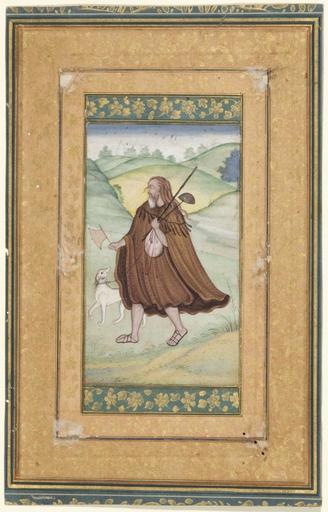MAKE A MEME
View Large Image

| View Original: | A_wandering_Shaivite_ascetic_with_his_dog.jpg (1633x2551) | |||
| Download: | Original | Medium | Small | Thumb |
| Courtesy of: | commons.wikimedia.org | More Like This | ||
| Keywords: A wandering Shaivite ascetic with his dog.jpg This work is a double-sided page from a bound album The painting depicting a Hindu ascetic walking with his dog in a pastoral landscape has been placed in a border decorated with a floral scroll painted in gold on a blue or pale orange ground; a similar border surrounds a calligraphy panel on the reverse side The border and the calligraphy panel are both somewhat later in date than the painting itself The painting of the ascetic and his dog is pasted onto an album page It is surrounded by a series of gold floral borders alternating blue and saffron-colored backgrounds Wearing a brown poncho-like garment and carrying a fan in his right hand and a bag of his belongings the lead attached to his white dog and some tools in his left he strides through the landscape He wears sandals and has long brown matted locks of hair and a graying beard The landscape consists of intersecting rounded forms in shades of green and yellow surmounted by trees along the top and with a larger blue-foliaged tree to the right near the horizon At the bottom a diagonal of yellowish rise of land with clumps of grass suggests some depth and a foreground but the figure is quite flat in the middle ground On the back of the page is a Panel of calligraphy consisting of a quatrain in Shah Jahan's handwriting signed Sultân Khurram his given name before he took the name Shah Jahan upon becoming emperor and dated 1020/1611-12 This is also surrounded by elaborate borders Subject Matter A Hindu ascetic walking with his dog in an idealized landscape with city buildings visible on the horizon This work dates to a pivotal moment in the history of Mughal painting the year when Jahangir replaced his father Akbar as emperor and chief patron of the imperial painting atelier Both father and son were fascinated by Hindu ascetics and frequently commissioned their artists to paint their portraits In this unsigned work an unnamed ascetic garbed in a flowing brown robe is seen striding purposefully through a landscape of gently rolling green hills accompanied by his dog Portraiture featuring a single figure shown in profile is a type that emerged under Akbar r 1565 “1605 but it was under Jahangir r 1605 “27 that it acquired greater psychological depth Every element of this naturalistic portrait demonstrates the skill and sensitivity of the Mughal artist from the careful study of foreground plants to the dignity of the saint-like figure and the silhouettes of trees in the distance The blue and green hues of the landscape are ultimately derived from Persian painting but the treatment of light and shadow and the close observation of nature have been learned from European art brought to the Mughal court by Jesuits diplomats and traders late 16th century - early 17th c http //quod lib umich edu/m/musart/x-1969-sl-2 175/1969_2_175 JPG chaperone S-MUSART-X-1969-SL-2 175+1969_2_175 JPG;from index;lasttype boolean;lastview thumbnail;med 1;resnum 10;sel9 ic_exact;sort relevance;start 1;subview detail;view entry;rgn1 ic_all;q1 mughal India Delhi-Agra Mughal PD-Art Uploaded with UploadWizard 16th-century Mughal miniatures Watercolor paintings of men of India Sadhus of India | ||||